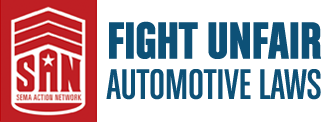<< Back to Driving Force, March 2012
Performance, Power & Polish
Three States Seek to Protect Modified Exhaust Systems
 The misconception that custom exhaust components are associated with illegal street racing has plagued the automotive hobby for decades and has created friction between vehicle enthusiasts and the law. In fact, unfair assumptions about modified exhaust systems have led some states to prohibit the use of this equipment, other than "factory-installed mufflers" or "mufflers meeting factory specifications." Others have banned systems that create "excessive or unusual noise." Subjective measures like these leave the fate of your vehicle in an uncertain limbo. While the SEMA Action Network (SAN) believes that exhaust systems should not be used in a way that causes overly loud or objectionable noise, these vague provisions fail to provide a clear and objective standard and make it difficult to know the parameters of acceptable modification.
The misconception that custom exhaust components are associated with illegal street racing has plagued the automotive hobby for decades and has created friction between vehicle enthusiasts and the law. In fact, unfair assumptions about modified exhaust systems have led some states to prohibit the use of this equipment, other than "factory-installed mufflers" or "mufflers meeting factory specifications." Others have banned systems that create "excessive or unusual noise." Subjective measures like these leave the fate of your vehicle in an uncertain limbo. While the SEMA Action Network (SAN) believes that exhaust systems should not be used in a way that causes overly loud or objectionable noise, these vague provisions fail to provide a clear and objective standard and make it difficult to know the parameters of acceptable modification.
To combat these issues, the SAN developed model exhaust noise legislation. In 2002, California was the first state to enact this model legislation into law. After 10 years, California's automotive hobbyists are now better equipped to fight unfair exhaust noise citations issued by state law enforcement officers. The law features fair, standardized testing that can be accurately measured. Results from the test settle whether or not a vehicle's modified exhaust system meets the state's exhaust noise standards. If the smog check station's referee determines that the exhaust system emits no more than 95-decibels, a certificate of compliance is issued.
Based on the success of California's exhaust noise test standard, other states have established fair noise limits, including Montana and Maine. Like California, these states have included the SAN provision for the testing of vehicle exhaust noise to the standard adopted by the Society of Automotive Engineers to an established noise limit of 95-decibels (SAE J1169). Under the SAE standard, a sound meter is placed 20 inches from the exhaust outlet at a 45-degree angle and the engine is revved to three quarters of maximum rated horsepower. The highest decibel reading is then recorded.
Recently, three additional states have made proposals to clear up the confusion once and for all. Hawaii, Iowa and West Virginia have just introduced bills that would benefit consumers and police officers charged with enforcing the law. "In incorporating the SAN model into their state statutes, this legislation recognizes that aftermarket exhaust systems are more durable, are designed to make vehicles run more efficiently without increasing emissions and offer increased performance, which can make a vehicle safer by improving its ability to merge, pass and travel uphill," said SEMA Vice President of Government Affairs Steve McDonald. "Further, these efforts challenge the erroneous assumption that enthusiasts who equip their vehicles with modified exhaust systems are involved in illegal street racing."
Similar to California, Maine and Montana, the Hawaii, West Virginia and Iowa legislation provide that vehicle exhaust systems in compliance with a 95-decibel limit under SAE J1169 satisfy requirements under the "noisy mufflers" law. We encourage SAN members in those three states to make their voices heard in support of these bills. For more information on each of these measures, please refer to the information posted at www.semasan.com.

